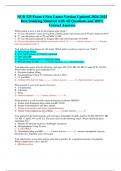Exam (elaborations)
NUR 325 Exam 4 New Latest Version Updated Best Studying Material with All Questions and 100% Correct Answers
- Course
- Institution
NUR 325 Exam 4 New Latest Version Updated Best Studying Material with All Questions and 100% Correct Answers
[Show more]



